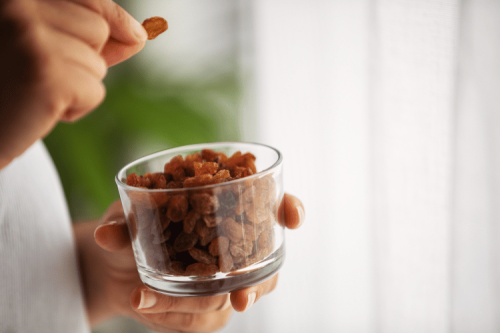
Your baby reaching the stage where they begin eating solid food is a pretty fantastic development. However, it also brings with it some adverse complications, especially when it comes to safe swallowing and eating techniques. One common source of frustration for parents and caretakers is the tendency for a baby to gag during eating, which sometimes leads to the false impression of the child choking. Gagging and choking are separate events that serve different functions and arise due to other mechanisms. Caregivers must be able to differentiate between the two to go through the weaning process confidently.
This post will focus on the literature available around these two phenomena, including their definitions, what causes them, and actions one should take in the event of each occurring. This post will also demonstrate and explain Australia’s ‘baby-led weaning’ approach which advocates for soft finger foods, ambrosial purees and strategies on how to limit the chances of the child choking. This information will be useful and enable you to build a positive and safe feeding experience for your baby. This is key for ensuring that your baby can transition seamlessly to khichri and other solid foods.
What's the difference between gagging and choking in babies?
It is quite critical to differentiate between what is gagging and what is choking. Both of these conditions have different physical causes and responses. Gagging is a reflex that prevents aspiration and occurs whenever food comes in contact with the infant’s tongue or throat. It is a normal part of consuming solids and is frequently associated with coughing and reddening of the face, including strangling or rough sounds. The critical element is that the child can breathe while gagging. Choking, then again occurs when his/her airway is breached by something entirely, thus there is no scope for breathing as well. It is a sure-shot alarm that is usually defined by the patient's difficulty in gasping, an inability to sob or spit, and blue skin around the mouth. Mastering the outline intricacies assists in effectively responding to the situation and ensures the baby’s safety while eating.
Understanding the gag reflex in infants
According to my findings, the gag reflex that infants display protects them from choking. It is triggered when food or objects touch the back of the tongue and is particularly pronounced in young infants. With time and practice of one’s food intake, this reflex begins to be expressed further along the oral cavity, thus enabling the child to be comfortable with solid foods. It should be noted that gagging is part of the development process and means that the baby is getting used to new textures in his or her mouth and learning to swallow them. As long as you keep calm and are aware of choking signs, you can help your child cope with solid foods without any problems.
Key Signs of Gagging vs. Choking
Knowing the difference between gagging and choking can be life-saving for the baby. Babies tend to shove food in their mouths, and instead of gagging, they start choking, which might lead to severe consequences. Here’s the best way to ensure that doesn’t happen:
Gagging Indicators:
- Loud noises: While a child is learning and feeding off an object, it is possible that the child will spin and cough, still ensuring the reflexes are intact.
- Face Color Change: Due to the loss of oxygen, the face color might change, but the patient will still manage to intake air through their breath.
- Awkward swallowing: When the baby’s gag reflex causes the tongue to move forward, the baby may chew the food or object, making their consumption awkward.
- Do Not Panic: Children often fend off the issue without help.
Choking Indicators:
- Silence: Choking makes breathing mute as youngsters end up crying, producing no sound or air.
- Change In Complexion: When a child suffers from a lack of oxygen, the mouth and the hands turn blue, making the child restless.
- Breathless: A child who cannot coax and takes multiple heavy breaths while feeling stressed indicates a choking scenario.
- Be Careful: Irrespective of the reason slumping can lead to fainting/breathlessness due to a shortage of oxygen.
Technical Parameters for Assessment:
- Breathing rate at rest: Infants generally breathe 30 to 60 times per minute. If there is a noticeable dip in the figure during an argument that suggests a child is choking, something should be done soon.
- Oxygen saturation levels (SpO2): Safe levels are mostly in the range of 95%- 100%. If choking occurs and the readings drop to 90 and below, it means that the person is severely choked and oxygen-deprived.
- Color assessment: If cyanosis around the mouth or the extremities is visible, it simply means the person does not have sufficient oxygen and needs some advanced ways to secure the airway.
These gaps in knowledge facilitate the providers to use their common sense and either provide the child who is gagging with some comfort or provide the one who is choking with attention as quickly as possible to prevent death. Appropriate techniques or managing strategies can eliminate the effects and problems that are created as a result of feeding and eating.
How to tell if your baby is choking or gagging
It’s common for a gagging baby to cough and gag and even get some tears in their eyes as their reflex gets activated to open the airway. A gagging baby doesn’t usually need medical attention since this is all part of their learning process of managing food or any object in their mouth. In such instances, however, a baby choking on something will try to breathe but sadly unable to as the airway is completely blocked. Therefore, it is mainly accompanied by a blueish skin discoloration, especially around the lips. If your baby is choking, it is an emergency and requires immediate response, which can include back replacements or chest thrusts. Always oversee your baby feeding or playing to differentiate between these two scenarios.
Why do babies gag during baby-led weaning?
Gagging is a normal reflex action babies possess to protect themselves from choking, while solid food is ingested during baby-led weaning. Gag response is a routine and automatic response that occurs when food has been propelled to the posterior of the mouth in preparation for swallowing. This is a more active reflex in younger infants that migrates further back into the mouth as they age and acquire more significant experience and oral motor development. Baby-led weaning triggers gagging, which helps babies develop chewing, food movement in their mouth, and swallowing reflex, which are necessary improvements for consuming solid foods.
The role of the gag reflex in learning to eat solids
Some refer to it as the ‘sucking reflex’; the `gag reflex` is the reflex that permits infants to learn how to intake solids without the risk of choking. It can also be described as a mechanism that prevents choking by moving substances away from the airway. Gagging could be distressing for Caregivers, but it is a regular occurrence that is critical for babies to chew, suck and swallow meals when going through a process known as `baby-led weaning` when the infants can eat other foods; slowly, the gag reflex dissipates, allowing them to eat smoothly. Believing in this paradigm helps me understand how my baby gags are the key element toward a phase where solid foods can be consumed.
Standard gagging patterns during the weaning journey
Gagging is a relatively standard and expected part of the early weaning process, and it is also not the same as choking. This happens as babies learn to eat solid food with different textures and sizes. Babies are born with a forward gag reflex, which is more sensitive, as it is positioned on the front of the tongue, which prevents them from swallowing unsuitable food. However, this reflex gradually wanes as the oral motor skills set in by around six to eight months, shifting progressively towards the inner side of the tongue.
Generally, gagging reduces during weaning as babies gradually learn how to chew correctly and when to swallow. For most infants, gagging is a common occurrence that mainly occurs when a baby develops different solid food pieces or after being breastfed when exposed to solid food for the first time. Parents should thus be cognizant of gagging patterns and other safety precautions, such as the preferred angle at which the baby should sit, which is a 90-degree angle, while taking soft yet appropriate pieces of food.
Key technical parameters include:
- Food size and texture, such as soft cooked foods, assist in the developmental stage, which is around 2-3 inches in length and can easily be grasped.
- Aids include ensuring further assistance, such as maintaining an unblocked baby’s airway while simultaneously being comfortable without compromising the seating.
- Watching how the infant develops ensures that different textures are introduced step by step to lessen the sensitivity of a baby’s gag reflex over time.
While most parents may be unaware of these trends, with patience and understanding, a parent can confidently assist the child during learning.
When gagging becomes less frequent as the baby gets older
Gagging in infants is expected to reduce with an increase in age and exposure to solids owing to the enhancement of oral motor skills with time. Such an advancement is, in my opinion, a result of a growing ability to chew as the infant takes in food, along with a gag reflex that gradually adjusts to the changing skill levels of the child. By giving a variety of safe foods and allowing them to take their time, you can aid this natural learning curve while promoting self-assurance with eating.
How can I prevent choking during baby-led weaning?
The key to minimizing choking risks when practicing baby-led weaning is following specific safety protocols. For instance, during mealtime, assist the baby in sitting in a straight upright position, which decreases the chances of choking on food and helps with proper swallowing. Offer foods such as soft, mashable ones, and cut them into long, thin strips or small, soft-sized bites, which are not very risky. Foods such as whole nuts, raw carrots, and apple slices should be avoided as they are considered too complex, round, sticky, or require more chewing. Sitting even at an arm’s distance may be helpful as long as you can watch your baby while hungry. Try to avoid directly feeding your baby or physically guiding the food towards their mouths, instead encourage them to slowly feed themselves. Lastly, learning child first aid is a good idea – at least the major ones useful in an emergency such as a choking.
Identifying and Avoiding Common Choking Hazards
One of the first rules to obey when introducing Baby-led Weaning is identifying the common choking hazards. Knowing what high-risk foods look like and how to modify them is essential to keep the 'baby fellow' safe. The key cult rips range from being challenging, round, and sticky to having difficulty chewing them. Some food examples include whole grapes, cherry tomatoes, hot dogs, popcorn, nuts, seeds, raw vegetables, and large chunks of meat or cheese.
Feeding a baby can be a difficult task. However, here are some Key Technical Parameters that will help in that process.
- Size: If you’re giving bite-sized pieces, they’re no bigger than half an inch (1.27 cm). This will make feeding easier and enhance the swallowing rate as well. On the flip side, long slim strips roughly the size of an adult finger can be self-fed quite easily.
- Texture: Give the baby pieces that can be easily mashed or cut between fingers or gums. Steamed vegetables, ripe fruits, or shredded meat are good options.
- Adhesiveness: Avoid sticky foods such as nut butter, marshmallows, and chewy candies, as they can stick to the windpipe region.
- Method of Cooking: Carrots and apples are good options, but boil them well. Moreover, ensure any meat served is done so once well cooked and shredded into smaller pieces.
- Shape: Cut round foods such as grapes and cherry tomatoes into lengthwise sections to eliminate the round shape end count.
Following these recommendations and paying close attention to your child while eating can help reduce choking hazards and ensure a better environment for your baby's feeding process.
Proper Food Preparation Techniques to Reduce Choking Risk
To further reduce the risk of choking during feeding, it is essential to apply meticulous food preparation methods, ensuring the texture and size of food are suitable for the infant's developmental stage. The consolidated expert recommendations:
- Cut and Shape Foods Appropriately: Foods should be cut into small, manageable pieces. For complex or round foods like carrots, grapes, or hot dogs:
- To prevent airway obstruction, slice foods into thin strips (~1/4 inch or ~0.6 cm thickness) or into small, irregular shapes.
- Round foods should be quartered lengthwise to eliminate the choking hazard of smooth, round objects.
- Modify Texture:
- Steaming, boiling, or baking can soften hard foods such as vegetables, fruits, or grains, making them easier to chew and swallow.
- Finely shred or mince meats into strands no larger than 2 inches (5 cm) to ensure tenderness and easy consumption.
- Avoid offering foods in solid or densely packed forms, such as large chunks of cheese or bread, as they may become lodged in the throat.
- Avoid High-Adhesion Foods:
- Spread sticky foods (e.g., peanut butter) thinly on bread or crackers to minimize adhesion risks.
- Opt for items with less cohesive textures while avoiding gummy or chewy snacks like candy or dried fruits.
- Consistent Quality Control:
- Regularly test food softness by mashing it between your fingers. It should disintegrate with minimal effort.
- For finger foods, ensure the consistency is firm enough to hold together and soft enough to break apart easily when chewed by gums or emerging teeth.
By implementing these preparation techniques and staying vigilant about food size, shape, and texture, guardians can further enhance feeding safety for their children. Always supervise meals, encourage slow eating, and teach proper chewing behaviors to foster safe eating habits.
Safe feeding practices to help prevent choking
When feeding children, my preliminary concern is to guarantee a safe eating environment by ensuring that the food is cut into age-appropriate sizes and that the food has been adequately textured. I try to avoid hard and small round foods such as whole grapes, nuts, or popcorn and sticky foods such as peanut butter, which tend to adhere when spread thin. As closely supervising meal times is essential, I urge the kids to sit straight while eating and remind them to chew calmly and consume food slowly. Moreover, I also make sure that children are less distracted while eating by screens or toys and the focus is solely on their meals.
What should I do if my baby is choking?
Staying calm is important when responding to an incident involving your baby choking. First, assess whether the airway is wholly or partially blocked. If the situation allows the baby to cry or cough, this is good, as it could help alleviate the sense of obstruction. If they cannot perform any of these actions and are in distress, then get emergency assistance. In the meantime, assume the baby is secure, focus on five fusillade strikes while holding them, and support their head and neck. This support ensures you are positioned correctly. If not, store five chest presses, which you will keep adding until the situation improves or medicals can come. The object can or cannot be removed, but regardless, always obtain the doctor’s information after the choking incident.
Recognizing the Signs of Choking in Infants
According to my observation, identifying the symptoms of choking in an infant is vital for the treatment. A choking infant can be rather alarming as they become completely silent, which means that they cannot cry, cough, or even breathe properly. Other outward symptoms include the child's hands flailing, face red or blue, or looking stressed out. Other times, a child may even put their hands around the neck. If the baby’s airway is partially blocked while choking, it is best to refrain from any immediate help and let the baby cough up the blockage on its own, but keep an eye on the situation. In a total blockage, quick application of the relevant technique is required. The fundamental technical details here concern ensuring that p[posture (head below chest for back blows) and chest thrust (1.5 inches’ depression approximately) pressure are right according to pediatric first-aid rules.
Step-by-step guide for performing back blows and chest thrusts
- Position the Infant
Lay the infant face down along your forearm, ensuring their head is supported and positioned lower than their chest. If needed, use your thigh or lap for additional stability. This positioning utilizes gravity to assist in clearing the airway.
- Administer Back Blows
Deliver up to 5 firm back blows between the infant’s shoulder blades using the heel of your hand. Following pediatric first-aid guidelines, ensure each blow is deliberate and forceful enough to dislodge the obstruction.
- Reposition for Chest Thrusts
If the obstruction persists, turn the infant onto their back while supporting their head, ensuring the head remains below the chest level to maximize effectiveness. Place two fingers just below the nipple line on the center of the chest.
- Perform Chest Thrusts
Using your two fingers, deliver up to 5 chest thrusts by pressing approximately 1.5 inches into the chest and allowing a full recoil after each compression. Each thrust should be steady and controlled to avoid excessive force.
- Repeat as Necessary
Alternate between 5 back blows and five chest thrusts until the object is dislodged and the infant can breathe normally or emergency medical services arrive. Constantly monitor the infant’s condition throughout the procedure.
Note: If the infant becomes unresponsive at any point, initiate CPR and seek immediate medical assistance while continuing efforts to clear the airway. Always adhere to current pediatric first-aid standards to ensure accuracy and safety.
When to Seek Emergency Medical Help
You must obtain emergency medical assistance without delay if the infant appears to be disinterested and passive, is in significant pain, or is devoid of proper cough, crying, or even breathing. If the baby’s condition deteriorates or your attempts to get the object out fail, you should call 911 or an emergency provider in your locality immediately. In any circumstance in which there is a threat to the child’s life, professional medical aid should always be the first option.
Is gagging normal during baby-led weaning?
Gagging is quite common among babies as they transition into self-feeding, which is a process that all babies must go through. It is an automatic action in which children throw up food that is too big to swallow, thus preventing choking. Choking is a blockage of the throat, whereas a gag is quite the opposite and a relief in distress. Parents should stay relaxed and observe, ensuring the baby doesn’t choke. Continuously monitor the meals and cut the food in age-appropriate partitions to aid eating development without choking risks.
Understanding gagging as a protective mechanism
Gagging assists infants in controlling the amount and texture of food as they start eating solids. In my understanding, it's an involuntary action that occurs when the back of the tongue or throat is pressed, forcing any excess or inappropriate amount of food that causes choking to be pushed out. Critical touchstone factors that need to be accounted for are the position of the food (placed a comfortable distance than over the back of the mouth), dimension of food chunks (the size should be that of the infant’s palm or less, which is approximately 1 - 2” for easier grabbing), and other related factors (thus cut food into small pieces that the baby’s jaw can chew). It is one of the essential evolutionary stages, and its presence gives further insight into when the child may require more help with manipulating food more safely.
How gagging helps babies learn to chew and swallow
Gagging is a reflex that lets babies grow chewing and swallowing skills. This reflex assists little children in moving food around their mouths, helping them to know where the food needs to be chewed and when it is ready to be swallowed. Every time a baby chews on a different size or texture of food, he or she develops the muscle skills associated with eating. With time, as the gag reflex is pushed to the back of the mouth, a child learns to gain better control over the chewing and swallowing the food.
Key technical parameters to consider for supporting this process include:
- Food Texture: It is always advisable to increase food variety, starting with pure, smooth, and soft pieces. These pieces encourage further exploration with the mouth.
- Volume of food: A child should be given an amount of food that he can comfortably rot in his mouth, and such pieces should be no more than his fist when eating alone. For example, 1 to 2 inches of soft sticks.
- Level of food: It should be a soft item, such as gum-mashed vegetables or very ripe fruit.
- Posture and Positioning: The babies should be erect with proper support to help them swallow easily without choking.
- Interaction and Alertness: Parents or the responsible person must pay attention to the process of gagging to assess their baby’s readiness and note any emerging patterns that may suggest problems with certain textures or sizes.
Increasing the availability of suitable food items enables the babies to have more opportunities to develop these skills in a safe and controlled setting, which eventually helps them become competent and confident eaters.
When to be concerned about excessive gagging
If excessive gagging occurs and renders day-to-day functioning difficult or breathing, swallowing, or nausea accompanies it, it can be a glaring red flag. Medically, frequent gagging can be a troubling symptom that can arise due to Gastroesophageal reflux disease, Secondary oral or pharyngeal infections, Neurological disorders, or even certain structural body deformities. If gagging is frequent for more than eight instances in a day or is sustained for more than a certain amount of time, feeling the gags can make many hate the feeling of being nauseous, losing weight, or feeling pain or swelling in the throat, then seeking professional assistance is highly suggested. To find out the precise reason for it, healthcare professionals may implant an endoscope into their patients and allow them to swallow barium or test the nerves.
References
Choking Infant First aidFrequently Asked Questions (FAQ)
Q: What's the difference between baby gagging and choking when starting solids?
A: Gagging is a normal, protective reflex that helps prevent choking. When a baby gags, it's still conscious and can cough or make noises. Choking, on the other hand, is a medical emergency in which the airway is blocked, and the baby can't breathe, cough, or make sounds. It's crucial to tell the difference between gagging and choking so that people can respond appropriately when introducing solid foods.Q: How can I tell if my baby is gagging or choking?
A: If your baby is gagging, they may cough, splutter, or make retching noises. Their face might turn red, but they can still breathe and make sounds. If they're choking, they'll be silent, unable to cough or cry, and may have a bluish tint to their skin. Constantly monitor your baby closely during mealtimes to quickly distinguish between gagging and choking.Q: Is gagging normal when a baby starts solids?
A: Gagging is a natural and common occurrence when a baby starts solids. It's a protective mechanism against choking and helps your baby learn to manage different food textures. The gag reflex will return to the mouth as your baby becomes more experienced eating solid foods.Q: What should I do if my baby is gagging on food?
A: If your baby is gagging, stay calm and allow them to work through it. Don't intervene unless they're showing signs of distress or choking. Gagging is a normal part of learning to eat and will help your baby develop their eating skills. Ensure you're offering age-appropriate foods and supervising all mealtimes.Q: What foods are a choking hazard for babies?
A: Some common choking hazards include whole grapes, nuts, hard candies, popcorn, raw vegetables, and large chunks of meat or cheese. When preparing baby food, always cut foods into small, manageable pieces and avoid these high-risk items until your child is older and can chew and swallow safely.Q: How can I help my baby gag less when introducing solid foods?
A: To help your baby gag less, start with smooth purees and gradually introduce more textured foods. Offer small amounts on a spoon, or let your baby self-feed with soft, finger-sized pieces. Be patient and allow your baby to set the pace. As they become more comfortable with different textures, their gag reflex naturally becomes less sensitive.Q: What first aid should I know in case my baby is choking?
A: Learning infant CPR and choking first aid is essential before starting solids. If your baby is choking, perform back blows and chest thrusts as recommended by the NHS. Never leave your baby alone while eating; always be prepared to act quickly if choking occurs. If you're unsure, seek immediate medical attention.Q: When should I start introducing solid foods to my baby?
A: The NHS recommends starting weaning around 6 months of age. By this time, most babies have developed the necessary skills for eating solids, such as sitting up with support and holding their heads steady. However, every baby is different, so consult your pediatrician before introducing solid foods.Q: How can I make the transition to solid foods safer for my baby?
A: Start with single-ingredient purees or soft, mashed foods to make the transition safer. Gradually introduce new textures and flavors. Always supervise mealtimes and ensure your baby is sitting upright. Cut foods into appropriate sizes and avoid known choking hazards. Be patient and allow your baby to explore foods at their own pace, which helps develop their chewing and swallowing skills.











 Login with Google
Login with Google Login with Facebook
Login with Facebook